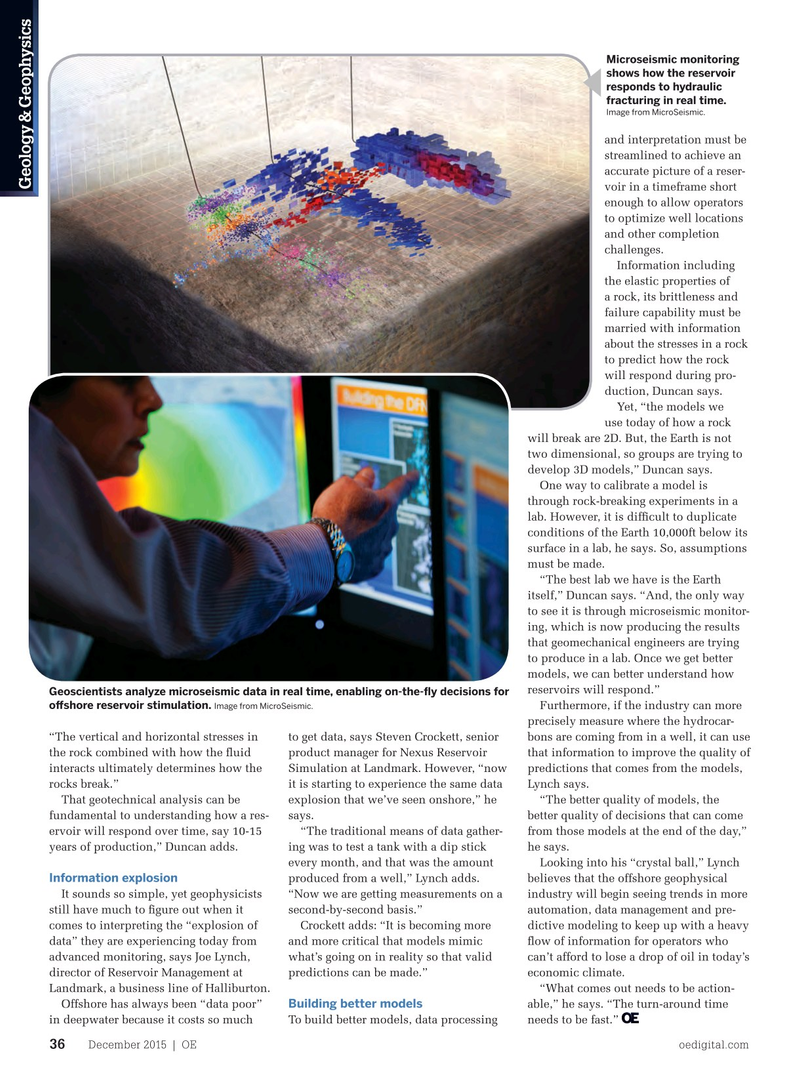
Page 34: of Offshore Engineer Magazine (Dec/Jan 2015)
Read this page in Pdf, Flash or Html5 edition of Dec/Jan 2015 Offshore Engineer Magazine
Microseismic monitoring shows how the reservoir responds to hydraulic fracturing in real time.
Image from MicroSeismic.
and interpretation must be streamlined to achieve an accurate picture of a reser-
Geology & Geophysics voir in a timeframe short enough to allow operators to optimize well locations and other completion challenges.
Information including the elastic properties of a rock, its brittleness and failure capability must be married with information about the stresses in a rock to predict how the rock will respond during pro- duction, Duncan says.
Yet, “the models we use today of how a rock will break are 2D. But, the Earth is not two dimensional, so groups are trying to develop 3D models,” Duncan says.
One way to calibrate a model is through rock-breaking experiments in a lab. However, it is diffcult to duplicate conditions of the Earth 10,000ft below its surface in a lab, he says. So, assumptions must be made.
“The best lab we have is the Earth itself,” Duncan says. “And, the only way to see it is through microseismic monitor- ing, which is now producing the results that geomechanical engineers are trying to produce in a lab. Once we get better models, we can better understand how reservoirs will respond.”
Geoscientists analyze microseismic data in real time, enabling on-the-fy decisions for ofshore reservoir stimulation. Image from MicroSeismic.
Furthermore, if the industry can more precisely measure where the hydrocar- “The vertical and horizontal stresses in to get data, says Steven Crockett, senior bons are coming from in a well, it can use the rock combined with how the fuid product manager for Nexus Reservoir that information to improve the quality of interacts ultimately determines how the Simulation at Landmark. However, “now predictions that comes from the models, rocks break.” it is starting to experience the same data Lynch says.
That geotechnical analysis can be explosion that we’ve seen onshore,” he “The better quality of models, the fundamental to understanding how a res- says. better quality of decisions that can come ervoir will respond over time, say 10-15 “The traditional means of data gather- from those models at the end of the day,” years of production,” Duncan adds. ing was to test a tank with a dip stick he says. every month, and that was the amount Looking into his “crystal ball,” Lynch
Information explosion produced from a well,” Lynch adds. believes that the offshore geophysical
It sounds so simple, yet geophysicists “Now we are getting measurements on a industry will begin seeing trends in more still have much to fgure out when it second-by-second basis.” automation, data management and pre- comes to interpreting the “explosion of Crockett adds: “It is becoming more dictive modeling to keep up with a heavy data” they are experiencing today from and more critical that models mimic fow of information for operators who advanced monitoring, says Joe Lynch, what’s going on in reality so that valid can’t afford to lose a drop of oil in today’s director of Reservoir Management at predictions can be made.” economic climate.
Landmark, a business line of Halliburton. “What comes out needs to be action-
Building better models
Offshore has always been “data poor” able,” he says. “The turn-around time in deepwater because it costs so much To build better models, data processing needs to be fast.”
December 2015 | OE oedigital.com 36 034_OE1215_G&G1_Heather.indd 36 11/20/15 6:54 PM

 33
33

 35
35